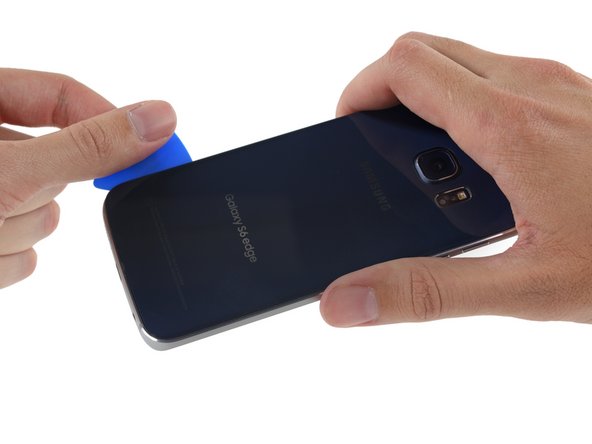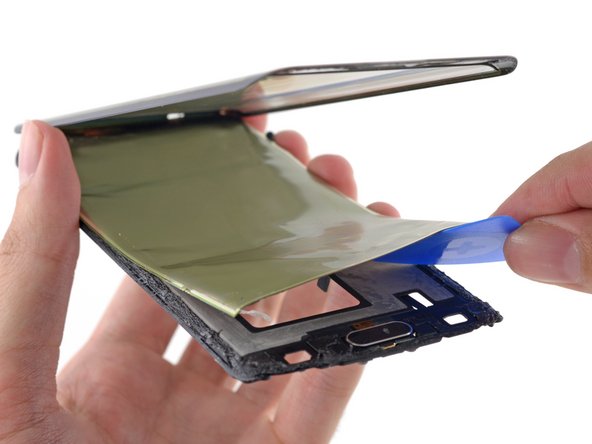News
Samsung Galaxy S6 Edge Teardown
Date: 01-25-2018 Click: 0Video Overview
Step 1 Samsung Galaxy S6 Edge Teardown

This new handset has some serious six appeal. Notable upgrades include:
5.1" Super AMOLED capacitive touchscreen (1440 x 2560, ~577 ppi, 16M colors)
Samsung Exynos 7 Octa 7420 Processor with integrated Mali-T760 GPU and 3 GB memory
16 MP rear camera with HDR, LED Flash, and 4K video recording
Built-in support for Qi and Powermat wireless charging
32/64/128 GB storage options (but no microSD slot)
Corning Gorilla Glass 4 backing
Step 2
The Edge is on, and so far we're impressed. With its sleek curves and sharp display, the S6 is like an infinity pool in the palm of your hand...
...except that it feels a lot less ergonomic, and is a total fingerprint magnet.
A quick peek from either side shows the Edge's information stream feature, bringing all of your important news, weather, and notifications to the side of your screen.
This way, when it's sitting on a table, you can see it from some (weird) new angles. Welcome to the future.
We catch a glimpse of the proximity and gesture sensors, as well as the front-facing camera—all sealed behind the Edge's Gorilla Glass.
Step 3
Living on the edge of the new Galaxy are the phone's speaker and microphone, as well as the audio jack and USB 2.0 port.
This view looks familiar.
The now-familiar heart rate monitor is visible below the LED flash, next to the rear camera.
Unfortunately, people are already having issues with the sensor.
A second microphone takes up residence on the top edge of the phone, along with the IR blaster and SIM tray.
Step 4
Now for a look at the back of this cutting-edge device. We note the model number—SM-G925T—and get to work dispatching the back cover.
Samsung stepped up the chic factor on the S6 and S6 Edge, opting for a screw-free glass back. This isn't exactly the first time we've seen this design trend.
Step 5
Our Opening Picks are instrumental in revealing the inside of the Edge.
Even our slim picks have trouble defeating the edges of this glass.
The back panel is removed (well, mostly). Underneath, we find a rather sticky situation... but it's nothing we can't handle.
Step 6
With a couple magic words (and some well-applied force), the adhered panel separates cleanly from the rest of the phone.
With the panel finally off, the adhesive peels off the glass nicely, but leaves a sticky residue on the metal midframe.
When we heard that the S6/S6 Edge shipped with a glass panel, we fell into 2011 flashback land; but after our sophisticated stress tests, it looks like glass has come a long way in four years.
Step 7
In every previous Galaxy phone—including even the repair-challenged Galaxy S5 of last year—this is the part where we got to pop out the battery with a fingernail.
Apparently Samsung wants to keep us disappointed, with a battery fully buried behind the midframe.
Our old friends, screwdriver and plastic opening tool, jump into the fray to help out. At least it looks like we're done with adhesive—the midframe comes off pretty easily, showing off all the goodies under the hood.
Step 8
With the midframe dispatched, we finally get a look at the battery and motherboard.
Yet again, we are disappointed. The battery isstill held captive, all the way under the motherboard.
By this point, we're also accustomed to being able to remove the expandable memory, in the form of a MicroSD card. Where is it? Oh, that's right—Samsung eliminated it. If you need additional storage, you'd better pay for it up-front; there'll be no adding it later.
The midframe is littered with goodies—tons of spring contacts, an NFC/wireless charging coil, and a speaker.
We'd love to get the battery out now and take a look, but for the moment we'll have to settle for disconnecting it from the motherboard.
Step 9
Labelled antennas on the midframe, how cute.
According to Samsung, the antennas are welded to the midframe via ultrasonic welding to provide stability and save on space.
We also found a hole in the spacetime continuum midframe for the power button.
Step 10
With all of its connectors popped, the motherboard is almost free of the display—it shares the same wonky, wrong-side IO board connection that we first saw in the Galaxy S5.
We pluck the main camera from the motherboard to get a better look at the hardware riding on its PCB:
Winbond W25Q32FW Serial Flash Memory
InvenSense IDG-2030 dual axis gyroscope for optical image stabilization
The 16 MP OIS rear-facing camera dwarfs the 5 MP selfie cam.
Step 11
As ChipWorks noted in their recent Galaxy S6 analysis, more and more of the chips in Samsung's flagship phones seem to be originating in-house. On the front side of the mobo, we find:
Samsung Exynos 7420 Octa-core Processor - 64-bit, 2.1 GHz Quad + 1.5 GHz Quad, with Samsung K3RG3G30MM-DGCH 3 GB LPDDR4 RAM layered in
Samsung KLUBG4G1BD 32GB NAND Flash
Skyworks 78041 Hybrid Multimode Multiband (MMMB) Front-End Module (FEM)
Avago AFEM-9020 PAM
Wolfson Microelectronics WM1840 Audio Codec and Maxim MAX98505 Class DG Audio Amplifier
Samsung N5DDPS3 - Similar to the N5DDPS2 spotted in the Galaxy S6, likely NFC Controller
InvenSense MP65M 6-Axis Accel + Gyro, and Samsung C2N89U (likely image processor)
Step 12
Flipping the motherboard exposes more control hardware and lots of power management ICs:
Samsung Shannon 928 RF Transceiver
Broadcom BCM4773 GNSS Location Hub
Avago ACPM-7007 PAM
Maxim MAX77843 Companion PMIC
Various Samsung Shannon PMICs
Step 13
A glass back and a stubbornly glued battery? Samsung, have you been hanging out with Apple?
Alass, the Apple tactics end all too soon. There are no handy pull tabs in sight, meaning this nasty adhesive needs to be picked away one strip at a time.
We assume that Samsung knows how much of a pain this is, given the markings found inside next to the battery.
Step 14
Free of its clingy mucilage, we get a better look at the 3.85 V, 10.01 Wh battery.
Samsung has stepped down from the 2800 mAh battery found in the Galaxy S5, and returned to a 2600 mAh battery like the S4.
Despite the smaller battery, some reviewers are finding that the Edge does indeed have a slightly longer battery life than its flatter predecessor.
Samsung claims that the Edge's battery will provide 12 hours of LTE web surfing, 26 hours of 3G WCDMA talk time, and up to 58 hours of music playback.
And it's fresh off the presses! Seriously, look at the date.
Step 15
In what seems like a(nother) major step backward, the S6 Edge dumps the lightning-fast Micro-B USB 3.0 port found on the Galaxy S5 in favor of a garden-variety microUSB (2.0) port.
Since Micro-B USB 3.0 ports are backward-compatible with standard USB 1.x/2.0 micro-B cable plugs, we fail to see the point. Apart from a slight space savings, there appears to be no benefit—certainly nothing to justify the ~90% drop in data transfer rates.
Welcome to the year 2000.
Step 16
According to Samsung, the curved glass is created by a process called 3D thermoforming, a process of heating and molding the glass. While it looks slick, it comes at a cost—in this case eight times the cost. That's right, what was once a part could now cost Samsung as much as due to low yields.
A recent report claims that Samsung's curved-glass supplier is only getting 50% yield, and that's pretty awful for the environment. Manufacturing is already rough enough on the planet, and this means they've got to make two screens for every phone.
Step 17
It bends! Peeling the display up shows just how Samsung's display curves around the sides of the phone.
Samsung's Super AMOLED display is what allows for the smooth curves on this screen.
These curves may round off the life of your display. Though the AMOLED screens found in many contemporary phones allow for thinner form factors, they have potentially shorter life expectancies.
Riding on the back of the display is the customary touchscreen controller, this time an STMicro FT6BH.
Step 18
The last component to come off the display assembly is the modular home button.
Unlike last year's swipe-to-unlock feature, this fingerprint sensor is touch-based.
Also unlike the S5, there's no need for any secret trap doors.
Thanks to ditching the display-out-first shenanigans of last year, we get a totally different path to the home button. Better? Meh. Probably not worse.
Step 19

Samsung Galaxy S6 Edge Repairability Score: 3 out of 10 (10 is easiest to repair).
Many components are modular and can be replaced independently.
In an improvement over the S5's design, you no longer have to remove the display to get into the phone and replace the motherboard.
Front and back glass make for double the crackability, and strong adhesive on the rear glass makes it very difficult to gain entry into the device.
The battery is very tightly adhered to the back of the display, and buried beneath the midframe and motherboard.
Replacing the glass without destroying the display is going to be very difficult.
Products Sort
- Finger Spinner
- Apple Mobile
- Samsung Mobile
- Xiaomi Mobile
- Huawei Mobile
- LG Mobile
- Motorola Mobile
- Sony Mobile
- Asus Mobile
- OPPO Mobile
- Meizu Mobile
- Vivo Mobile
- LeEco Mobile
- Mobile Phone TOOLS
- PlayStation4
- PlayStation3
- PlayStation2 & PS1
- PSP1000/2000/3000/Go/PSV
- Xbox360 & Xbox & One
- Wii & GameCube
- NDS lite/NDS-i/3DS/3DS XL/2DS
- ND & GBA
- Memory Card
- DS Flash Card
- ModChip
- Other accessories
- Samsung Galaxy S6 Edge Teardown










































